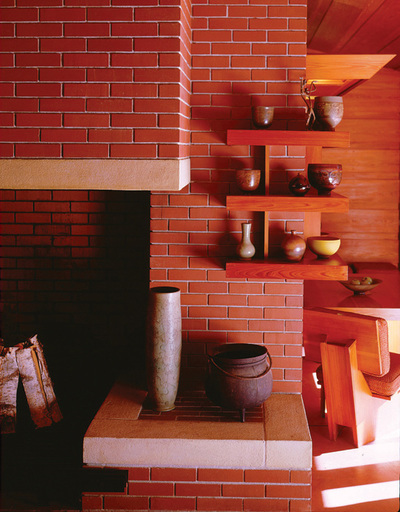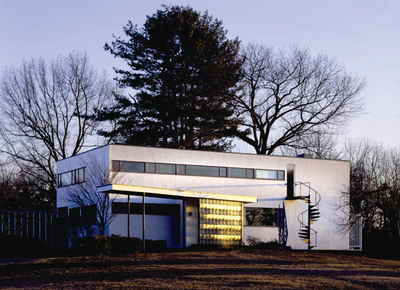Age of the Modern Home
Winter dusk at the Glass House, New Canaan, CT.
Photo: © Robin Hill. Courtesy of the Glass House.
Once upon a time, modern houses had the reputation for being architecture’s ugly stepchildren. Ignored and abandoned, many were simply knocked down and replaced by new homes.
Not any more. Interest in modern houses (especially those by celebrated architects) has reached an all-time high. “Starchitects,” such as Frank Gehry, Rem Koolhaas and Zaha Hadid, have brought radical architecture into the mainstream. Thus, modern homes, once considered avant-garde, now look quite tame and accessible.
Natascha Drabbe, founding chair of the Iconic Houses Network, which offers an international map and index of modern house museums, sees a spike in growth. Over the past five years, 30 modern house museums have opened or will open soon. That’s roughly the same number of modern house museums that opened between 1990 and 2010—a 20-year span.
Why this surging interest in modernism? David Fixler, principal at EYP Architecture and Engineering and president of the New England chapter of Docomomo, an international organization devoted to saving modern architecture, says that modernist homes “laid the groundwork” for contemporary architecture. Thus, they seem more relevant today than many historic homes, which have a decline in visitors. Two demographic groups, as seen in Docomomo’s New England membership, are highly interested in modern homes: soon-to-be retirees who grew up with modernism, and millennials who view modern homes as historically significant.
“Modern house museums are on the upswing,” says Kimberli Meyer, director of the MAK Center for Art and Architecture in Los Angeles. “It wasn’t that long ago that it was hard to convince preservationists that it was important to preserve modern houses…”
The New Canaan Historical Society is a case in point. An early promoter of modernism, the Society, in 2002, began offering a biennial tour of area modernist houses designed from 1940 to 1980 by well-known architects. Janet Lindstrom, the society’s executive director, says the event has grown so popular, it usually sells out in advance. The society will conduct its next tour in the fall of 2016. Those who can’t wait will find 16 modern New Canaan homes explored in detail in a brand new book Midcentury Houses Today, published last October by the Monacelli Press.
The Gropius House in Lincoln, MA, was among the first generation of modern house museums to open to the public. Walter Gropius designed the house for himself and his family in 1938—one year after they moved from Germany. The little white box of a home was bequeathed in 1979 to the Society of Preservation of New England Antiquities (now Historic New England), and opened it to the public in 1985.
At first, the house attracted only about 3,000 visitors annually, not surprising since post-modern architecture was in vogue. Over the last 10 years, visitor numbers have been steadily on the rise with an eight percent increase over the last six years. The house had 7,550 visitors in 2014. Given the small size of the house, tours are limited to groups of 10. Even so, Gropius House, along with the 1907-built Beauport in Gloucester, MA, leads Historic New England’s museums in terms of visitor growth, according to Wendy Hubbard, Gropius House site manager.
The Frank Lloyd Wright designed Zimmerman House. Courtesy of Currier Museum of Art, 2012.
The Zimmerman House, located in Manchester, NH, reports a similar rise in visitors. Owned and operated by the nearby Currier Museum of Art, the small ranch house was designed by Frank Lloyd Wright in 1950 for a local couple, Isadore J. and Lucille Zimmerman. It is New England’s only Wright home open to the public. The Currier offers limited tours and restricts groups to 14 or less, largely due to the home’s size. Even so, visitor numbers have grown 17 percent over the last five years, reaching 4,400 visitors in 2014. Many visitors are Frank Lloyd Wright pilgrims—some international—determined to see all the Wright homes and buildings.
The hyped public opening of the Glass House, in 2007, according to Kimberli Meyer, proved to be a pivotal moment for modern house museums as it showed that they can be significant cultural players. The Glass House, designed by Philip Johnson for himself and his partner, David Whitney, is really a campus composed of eight separate buildings built over a 46-year span, 1949 to 1995, on 49 rolling acres. Between Gropius House and Zimmerman House, the Glass House has the most circumscribed tour schedule, given that it’s closed five months of the year. Still, it attracts 4,000 to 13,000 visitors annually and has the highest number of international visitors—10 percent of overall attendance in 2014, according to Communications Director Christa Carr.
It helps that the Glass House is so close to New York City, where the art-going public can easily hop a 70-minute commuter train to New Canaan and be whisked there by a shuttle bus. The curatorial staff creates an ambitious schedule of changing events to attract repeat visitors—the holy grail of house museums.
Last year, the Glass House commissioned a site-specific installation by international artist Fujiko Nakaya that covered the main house in fog for 10 minutes each hour, which played with the sense of transparency and spaciousness that one normally feels standing inside of Johnson’s glass structure. Irene Shum Allen, the Glass House’s curator and collections manager, can’t reveal what installations are slated for 2015, but says that the museum will continue to invite artists and designers whose work “activates the space” and responds not only to the architectural campus, but to the landscape surrounding it, leading visitors to experience the place differently in different seasons.
Drabbe sees this kind of programming as essential to modern house museums’ long-term viability. Ticket sales provide an important part of the funding needed to maintain and restore these homes, many of them constructed with novel and innovative materials that are difficult and expensive to conserve and repair.
If such initiatives succeed, they may help solve serious funding issues. According to a 2013 speech by Stephanie Meeks, president of the National Trust for Historic Preservation, the average house museum in 2002 took in $8 per visitor, yet incurred costs of $40 per visitor. Thus, the trust encourages efforts to find alternative and innovative uses for historic homes that can preserve them without necessarily turning them into house museums.
Meyer says that while this trend in innovative programming is rising, it also blurs the line between modern house museum and art museum. She notes that some preservationists resist this, seeing higher visitor numbers as synonymous with wear and tear. However, for her and many other directors of modern house museums, innovative programming creates the type of radical salon culture initiated by many of these homes’ original owners, who were often important leaders in the avant-garde.
Of the three, the Gropius House is the most surprising as it feels, inside, nothing like it looks in photographs. It is warm, domestic and lively—a family house enlivened by the homespun use of different, highly tactile yet simple materials, including painted clapboard, striated glass block, cork and even fishing nets (used like primitive curtains on the upstairs windows).
The living room’s large plate glass window is not coolly industrial, but a means of bringing the surrounding landscape into the house, signaling a connection and even affection for the apple orchard and native trees surrounding the home on its little hill. This is a house that reaches out towards the landscape, not only through its carefully framed views, but also by its details, such as its two horizontal trellises reaching from house to landscape that were covered by vines planted by Mrs. Gropius.
Exterior of Gropius House. The north elevation highlights the center entrance with a glass block portico at sunset. Courtesy of Historic New England.
The Glass House, which Johnson described as “the diary of an eccentric architect,” is different in its ambitions, a pure experiment in design that was carried out over many years by an architect who had plenty of land to work with and also the means to do it. It is beautiful and austere, classical and romantic, contemplative and a bit ironic.
Like Gropius, Johnson was deferential to the landscape, not only framing certain views (or all views, in the main house, which is almost wholly made of glass), but also placing each of the eight structures on the land in such a way that they imbue the landscape with drama and consequence—just like the sole painting Johnson kept in the main house, Burial of Phocion (1648–49) by Nicolas Poussin, in which an abundant overgrowth of trees, shrubs and vines obscures a small city in the background.
The Zimmerman House strikes the only note of ambivalence about nature, which is surprising as Wright is the architect that is considered most tuned into the materials, shapes and rhythms of the natural world. It features extensive plate glass windows and other details that collapse the distinction between inside and out, yet the overall effect inside is of being enclosed, sheltered and protected as in a primitive lean-to, a feeling that is carefully constructed by Wright through its peaked roof—its warm cypress roof planks visible from all points inside the house—its monochromatic color scheme of brown and maroon and a unique system of decorative wooden overhangs that course around the home’s interior about seven feet off the ground.
Where Gropius House and the Glass House put nature on display, the Zimmerman House resists, urging us to appreciate the primitive strength and richness of architecture itself.
Of course, seeing these modern houses requires effort, as visitors must track them down. The Iconic Houses Network makes it easier with maps and addresses on its website, iconichouses.org. Let the pilgrimages begin.
Marisa Angell Brown is an architectural historian, curator, critic and the president of Genie Loci.




